Mapping Early, Middle and Late Rice Extent Using Sentinel-1A and Landsat-8 Data in the Poyang Lake Plain, China
Abstract
1. Introduction
2. Materials and Methods
2.1. Study Area
2.2. Sentinel-1A Data and Preprocessing
2.3. Landsat-8 Data and Preprocessing
2.4. Auxiliary Data and Accuracy Assessment
2.5. Enhanced Paddy Rice Information
2.6. Cropland Extraction
2.7. Comprehensive Mapping of Paddy Rice Extent
3. Results
3.1. Accuracy Assessment
3.2. Paddy Rice Extent
4. Discussion
- (1)
- Reducing image data redundancy and compressing image data. For instance, the 15 image bands (668 MB) were reduced to three image sets (342 MB) after enhancement.
- (2)
- Resolving the phenological differences (on the S1A time series) that were caused by differences in planting time and satellite transit time. For example, in one of the images there were two croplands, with planting times of 12 April and 6 May. Therefore, each had different backscattering coefficient dynamics. Such phenological differences present challenges for traditional classification methods.
5. Conclusions
Acknowledgments
Author Contributions
Conflicts of Interest
References
- Khush, G.S. What it will take to feed 5.0 billion rice consumers in 2030. Plant Mol. Biol. 2005, 59, 1–6. [Google Scholar] [CrossRef] [PubMed]
- Elert, E. A good grain. Nature 2014, 514, S50–S51. [Google Scholar] [CrossRef] [PubMed]
- Dong, J.W.; Xiao, X.M.; Menarguez, M.A.; Zhang, G.L.; Qin, Y.W.; Thau, D.; Biradar, C.; Moore, B. Mapping paddy rice planting area in northeastern asia with Landsat 8 images, phenology-based algorithm and Google Earth Engine. Remote Sens. Environ. 2016, 185, 142–154. [Google Scholar] [CrossRef] [PubMed]
- Shao, Y.; Liao, J.J.; Wang, C.Z. Analysis of temporal radar backscatter of rice: A comparison of SAR observations with modeling results. Can. J. Remote Sens. 2002, 28, 128–138. [Google Scholar] [CrossRef]
- Sass, R.L.; Cicerone, R.J. Photosynthate allocations in rice plants: Food production or atmospheric methane? Proc. Natl. Acad. Sci. USA 2002, 99, 11993–11995. [Google Scholar] [CrossRef] [PubMed]
- Dong, J.; Xiao, X. Evolution of regional to global paddy rice mapping methods: A review. ISPRS J. Photogramm. Remote Sens. 2016, 119, 214–227. [Google Scholar] [CrossRef]
- Mosleh, M.K.; Hassan, Q.K.; Chowdhury, E.H. Application of remote sensors in mapping rice area and forecasting its production: A review. Sensors 2015, 15, 769–791. [Google Scholar] [CrossRef] [PubMed]
- Gumma, M.K.; Nelson, A.; Thenkabail, P.S.; Singh, A.N. Mapping rice areas of South Asia using modis multitemporal data. J. Appl. Remote Sens. 2011, 5, 053547. [Google Scholar] [CrossRef]
- Zhao, J.; Xu, C.; Huang, L.; Zhang, D.; Liang, D. Characterisation of spatial patterns of regional paddy rice with time series remotely sensed data. Paddy Water Environ. 2015, 14, 439–449. [Google Scholar] [CrossRef]
- Chang, S.H.; Wan, S.A. A novel study on ant-based clustering for paddy rice image classification. Arab. J. Geosci. 2015, 8, 6305–6316. [Google Scholar] [CrossRef]
- Li, Q.Z.; Zhang, H.X.; Du, X.; Wen, N.; Tao, Q.S. County-level rice area estimation in southern China using remote sensing data. J. Appl. Remote Sens. 2014, 8, 083657. [Google Scholar] [CrossRef]
- Wan, S.; Lei, T.C.; Chou, T.Y. An enhanced supervised spatial decision support system of image classification: Consideration on the ancillary information of paddy rice area. Int. J. Geogr. Inf. Sci. 2010, 24, 623–642. [Google Scholar] [CrossRef]
- Chang, S.H. A novel approach to developing a supervised spatial decision support system for image classification: A study of paddy rice investigation. Math. Probl. Eng. 2014, 2014, 804548. [Google Scholar] [CrossRef]
- Zhao, Q.Y.; Lenz-Wiedemann, V.I.S.; Yuan, F.; Jiang, R.F.; Miao, Y.X.; Zhang, F.S.; Bareth, G. Investigating within-field variability of rice from high resolution satellite imagery in Qixing Farm County, Northeast China. ISPRS Int. J. Geo-Inf. 2015, 4, 236–261. [Google Scholar] [CrossRef]
- Liu, M.L.; Liu, X.N.; Zhang, B.Y.; Ding, C. Regional heavy metal pollution in crops by integrating physiological function variability with spatio-temporal stability using multi-temporal thermal remote sensing. Int. J. Appl. Earth Obs. Geoinf. 2016, 51, 91–102. [Google Scholar] [CrossRef]
- More, R.S.; Manjunath, K.; Jain, N.K.; Panigrahy, S.; Parihar, J.S. Derivation of rice crop calendar and evaluation of crop phenometrics and latitudinal relationship for major south and south-east Asian countries: A remote sensing approach. Comput. Electr. Agric. 2016, 127, 336–350. [Google Scholar] [CrossRef]
- Wang, J.; Huang, J.; Gao, P.; Wei, C.W.; Mansaray, L.R. Dynamic mapping of rice growth parameters using HF-1 CCD time series data. Remote Sens. 2016, 8, 931. [Google Scholar] [CrossRef]
- Kontgis, C.; Schneider, A.; Ozdogan, M. Mapping rice paddy extent and intensification in the Vietnamese Mekong River Delta with dense time stacks of Landsat data. Remote Sens. Environ. 2015, 169, 255–269. [Google Scholar] [CrossRef]
- Su, T. Efficient paddy field mapping using Landsat-8 imagery and object-based image analysis based on advanced fractel net evolution approach. GISci. Remote Sens. 2016, 54, 354–380. [Google Scholar] [CrossRef]
- Teluguntla, P.; Ryu, D.; George, B.; Walker, J.P.; Malano, H.M. Mapping flooded rice paddies using time series of MODIS imagery in the Krishna River Basin, India. Remote Sens. 2015, 7, 8858–8882. [Google Scholar] [CrossRef]
- Torbick, N.; Salas, W. Mapping agricultural wetlands in the sacramento valley, USA with satellite remote sensing. Wetlands Ecol. Manag. 2015, 23, 79–94. [Google Scholar] [CrossRef]
- Li, S.H.; Xiao, J.T.; Ni, P.; Zhang, J.; Wang, H.S.; Wang, J.X. Monitoring paddy rice phenology using time series MODIS data over Jiangxi Province, China. Int. J. Agric. Biol. Eng. 2014, 7, 28–36. [Google Scholar]
- Son, N.T.; Chen, C.F.; Chen, C.R.; Chang, L.Y.; Duc, H.N.; Nguyen, L.D. Prediction of rice crop yield using MODIS EVI-LAI data in the Mekong Delta, Vietnam. Int. J. Remote Sens. 2013, 34, 7275–7292. [Google Scholar] [CrossRef]
- Yu, F.H.; Xu, T.Y.; Cao, Y.L.; Yang, G.J.; Du, W.; Wang, S. Models for estimating the leaf NDVI of japonica rice on a canopy scale by combining canopy NDVI and multisource environmental data in northeast China. Int. J. Agric. Biol. Eng. 2016, 9, 132–142. [Google Scholar]
- Guan, X.D.; Huang, C.; Liu, G.H.; Meng, X.L.; Liu, Q.S. Mapping rice cropping systems in vietnam using an NDVI-based time-series similarity measurement based on DTW distance. Remote Sens. 2016, 8, 19. [Google Scholar] [CrossRef]
- Oyoshi, K.; Tomiyama, N.; Okumura, T.; Sobue, S.; Sato, J. Mapping rice-planted areas using time-series synthetic aperture radar data for the Asia-rice activity. Paddy Water Environ. 2016, 14, 463–472. [Google Scholar] [CrossRef]
- Zhang, Y.; Wang, C.Z.; Wu, J.P.; Qi, J.G.; Salas, W.A. Mapping paddy rice with multitemporal ALOS/PALSAR imagery in southeast China. Int. J. Remote Sens. 2009, 30, 6301–6315. [Google Scholar] [CrossRef]
- Ul-Haq, Z.; Tariq, S.; Ali, M. Atmospheric variability of methane over Pakistan, Afghanistan and adjoining areas using retrievals from SCIAMACHY/ENVISAT. J. Atmos. Sol.-Terr. Phys. 2015, 135, 161–173. [Google Scholar] [CrossRef]
- Motohka, T.; Nasahara, K.N.; Miyata, A.; Mano, M.; Tsuchida, S. Evaluation of optical satellite remote sensing for rice paddy phenology in monsoon Asia using a continuous in situ dataset. Int. J. Remote Sens. 2009, 30, 4343–4357. [Google Scholar] [CrossRef]
- Xiao, X.M.; Boles, S.; Liu, J.Y.; Zhuang, D.F.; Frolking, S.; Li, C.S.; Salas, W.; Moore, B. Mapping paddy rice agriculture in southern China using multi-temporal MODIS images. Remote Sens. Environ. 2005, 95, 480–492. [Google Scholar] [CrossRef]
- Nguyen, D.B.; Gruber, A.; Wagner, W. Mapping rice extent and cropping scheme in the Mekong Delta using Sentinel-1A data. Remote Sens. Lett. 2016, 7, 1209–1218. [Google Scholar] [CrossRef]
- Ribbes, F.; Le Toan, T. Rice field mapping and monitoring with radarsat data. Int. J. Remote Sens. 1999, 20, 745–765. [Google Scholar] [CrossRef]
- Yang, S.; Shen, S.; Li, B.; Le Toan, T.; He, W. Rice mapping and monitoring using ENVISAT ASAR data. IEEE Geosci. Remote Sens. Lett. 2008, 5, 108–112. [Google Scholar] [CrossRef]
- Torbick, N.; Chowdhury, D.; Salas, W.; Qi, J.G. Monitoring rice agriculture across myanmar using time series Sentinel-1 assisted by Landsat-8 and Palsar-2. Remote Sens. 2017, 9, 112. [Google Scholar] [CrossRef]
- Plank, S. Rapid damage assessment by means of multi-temporal SAR—A comprehensive review and outlook to Sentinel-1. Remote Sens. 2014, 6, 4870–4906. [Google Scholar] [CrossRef]
- Torres, R.; Snoeij, P.; Geudtner, D.; Bibby, D.; Davidson, M.; Attema, E.; Potin, P.; Rommen, B.; Floury, N.; Brown, M.; et al. Gmes Sentinel-1 mission. Remote Sens. Environ. 2012, 120, 9–24. [Google Scholar] [CrossRef]
- Jung, H.S.; Lu, Z.; Zhang, L. Feasibility of along-track displacement measurement from Sentinel-1 interferometric wide-swath mode. IEEE Trans. Geosci. Remote Sens. 2013, 51, 573–578. [Google Scholar] [CrossRef]
- Cazals, C.; Rapinel, S.; Frison, P.L.; Bonis, A.; Mercier, G.; Mallet, C.; Corgne, S.; Rudant, J.P. Mapping and characterization of hydrological dynamics in a coastal marsh using high temporal resolution Sentinel-1A images. Remote Sens. 2016, 8, 17. [Google Scholar] [CrossRef]
- Mansaray, L.R.; Huang, W.J.; Zhang, D.D.; Huang, J.F.; Li, J. Mapping rice fields in urban Shanghai, southeast China, using Sentinel-1A and Landsat 8 datasets. Remote Sens. 2017, 9, 257. [Google Scholar] [CrossRef]
- Li, Y.; Zhang, Q.; Li, X.; Yao, J. Hydrolgical effects of Poyang Lake catchment in response to climate changes. Resour. Environ. Yangtze Basin 2013, 22, 1339–1347. [Google Scholar]
- Sentinel Application Platform (SNAP) Software, Version 6.0. European Space Agency (ESA). The SENTINEL-1 Toolbox. Available online: https://sentinel.esa.int/web/sentinel/toolboxes/sentinel-1 (accessed on 21 November 2017).
- Li, K.; Shao, Y.; Zhang, F. Rice information extraction using multi-polarization airborne synthetic aperture radar data. J. Zhejiang Univ. Agric. Life Sci. 2011, 37, 181–186. [Google Scholar]
- Tian, H.; Wu, M.; Niu, Z.; Wang, C.; Zhao, X. Dryland crops recognition under complex planting structure based on radarsat-2 images. Trans. Chin. Soc. Agric. Eng. 2015, 31, 154–159. [Google Scholar]
- Gupta, K.K.; Gupta, R. Despeckle and geographical feature extraction in SAR images by wavelet transform. ISPRS J. Photogramm. Remote Sens. 2007, 62, 473–484. [Google Scholar] [CrossRef]
- Schmidt, K.S.; Skidmore, A.K. Smoothing vegetation spectra with wavelets. Int. J. Remote Sens. 2004, 25, 1167–1184. [Google Scholar] [CrossRef]
- Dao, P.; Liou, Y.-A. Object-based flood mapping and affected rice field estimation with Landsat 8 oli and MODIS data. Remote Sens. 2015, 7, 5077–5097. [Google Scholar] [CrossRef]
- Wang, J.; Xiao, X.; Qin, Y.; Dong, J.; Zhang, G.; Kou, W.; Jin, C.; Zhou, Y.; Zhang, Y. Mapping paddy rice planting area in wheat-rice double-cropped areas through integration of Landsat-8 oli, MODIS, and palsar images. Sci. Rep. 2015, 5, 10088. [Google Scholar] [CrossRef] [PubMed]
- Olofsson, P.; Foody, G.M.; Stehman, S.V.; Woodcock, C.E. Making better use of accuracy data in land change studies: Estimating accuracy and area and quantifying uncertainty using stratified estimation. Remote Sens. Environ. 2013, 129, 122–131. [Google Scholar] [CrossRef]
- Zuperku, E.J.; Prkic, I.; Stucke, A.G.; Miller, J.R.; Hopp, F.A.; Stuth, E.A. Automatic classification of canine prg neuronal discharge patterns using k-means clustering. Respir. Physiol. Neurobiol. 2015, 207, 28–39. [Google Scholar] [CrossRef] [PubMed]
- Hu, Y.; Zhao, C.X. Unsupervised Texture Classification by Combining Multi-Scale Features and k-Means Classifier; IEEE: New York, NY, USA, 2009; pp. 364–368. [Google Scholar]
- Venkatalakshmi, K.; Shalinie, S.M. Multispectral image classification using modified k-means algorithm. Neural Netw. World 2007, 17, 113–120. [Google Scholar]
- Tian, H.; Li, W.; Wu, M.; Huang, N.; Li, G.; Li, X.; Niu, Z. Dynamic monitoring of the largest freshwater lake in China using a new water index derived from high spatiotemporal resolution Sentinel-1A data. Remote Sens. 2017, 9, 521. [Google Scholar] [CrossRef]
- Pal, M. Random forest classifier for remote sensing classification. Int. J. Remote Sens. 2005, 26, 217–222. [Google Scholar] [CrossRef]
- Li, W.J.; Fu, H.H.; Yu, L.; Gong, P.; Feng, D.L.; Li, C.C.; Clinton, N. Stacked autoencoder-based deep learning for remote-sensing image classification: A case study of African land-cover mapping. Int. J. Remote Sens. 2016, 37, 5632–5646. [Google Scholar] [CrossRef]


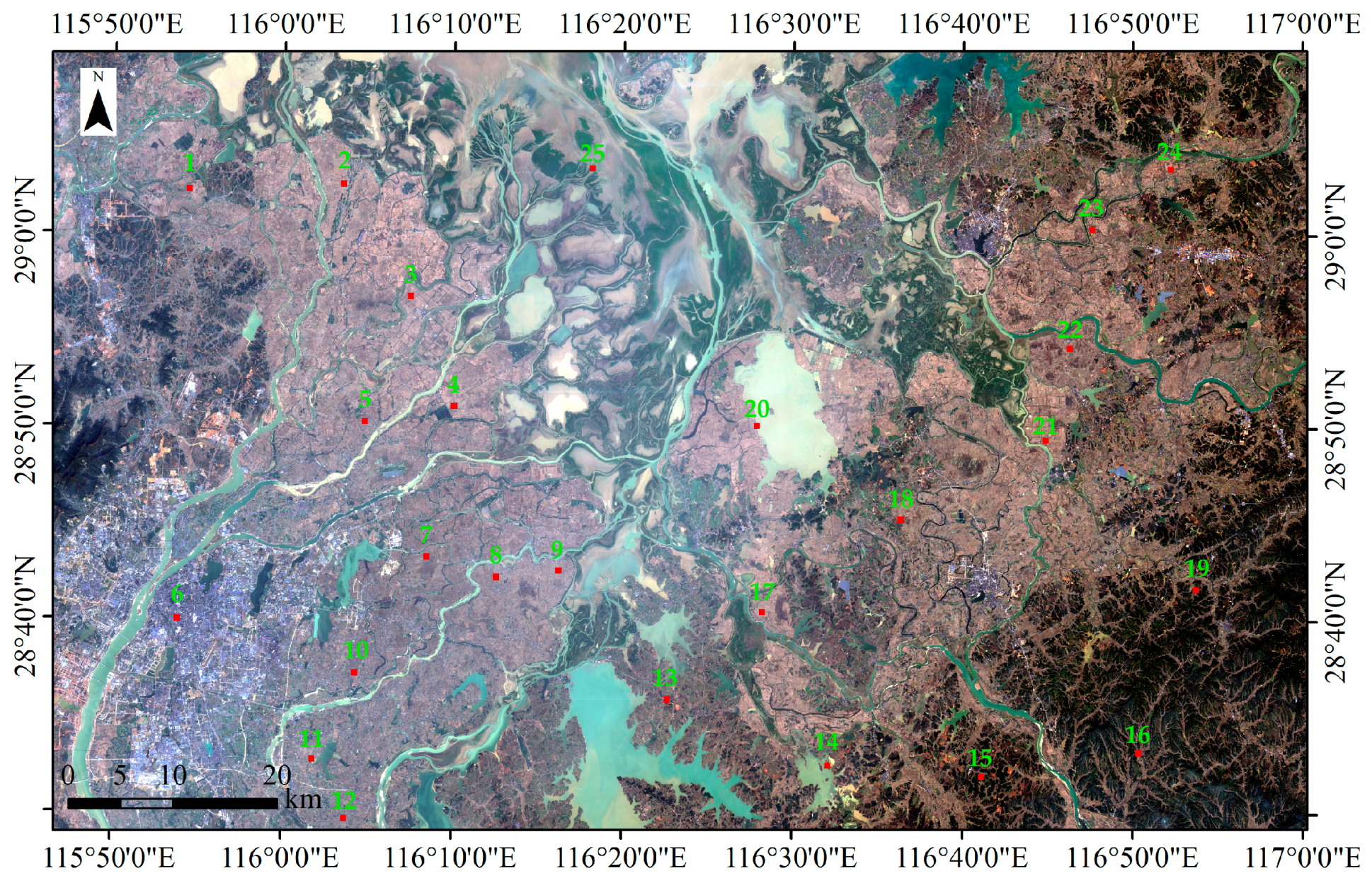
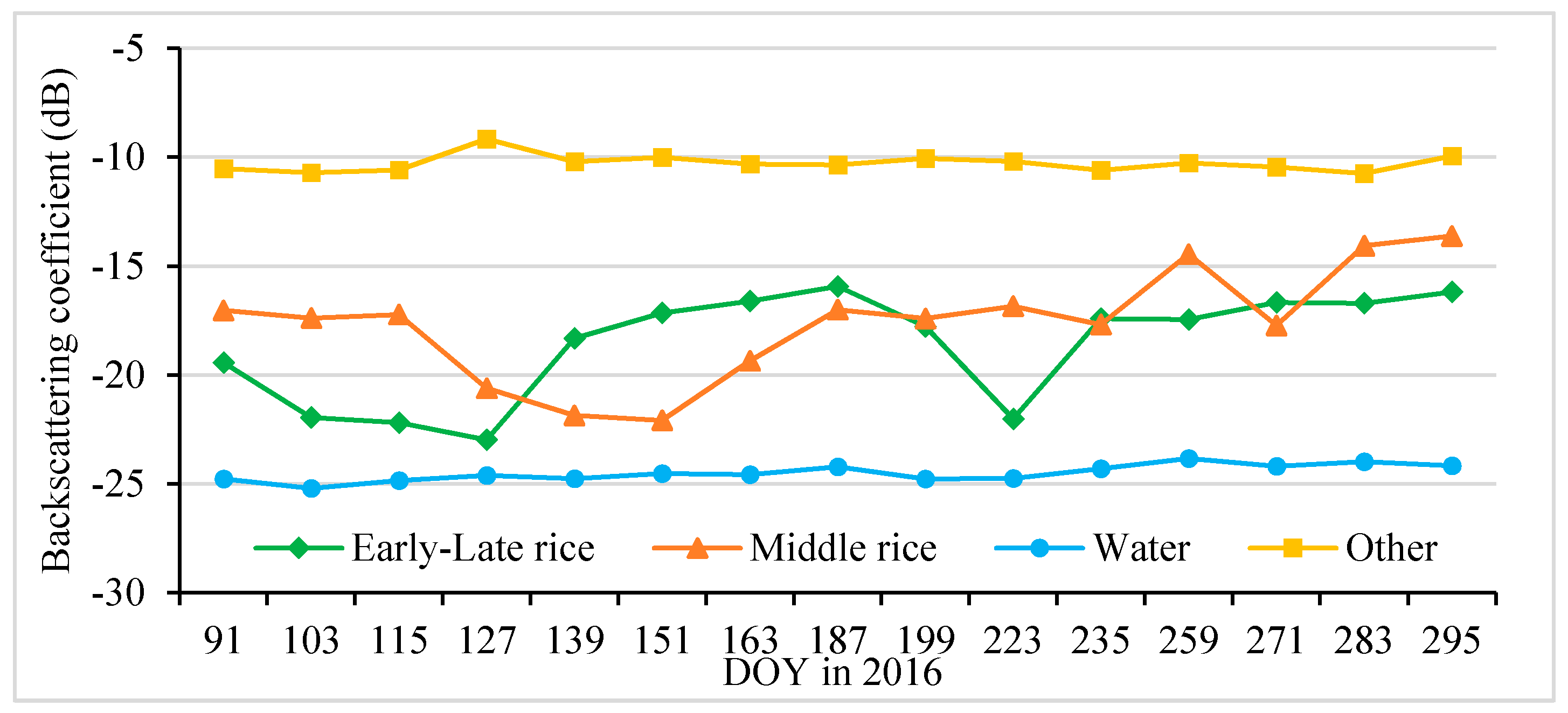

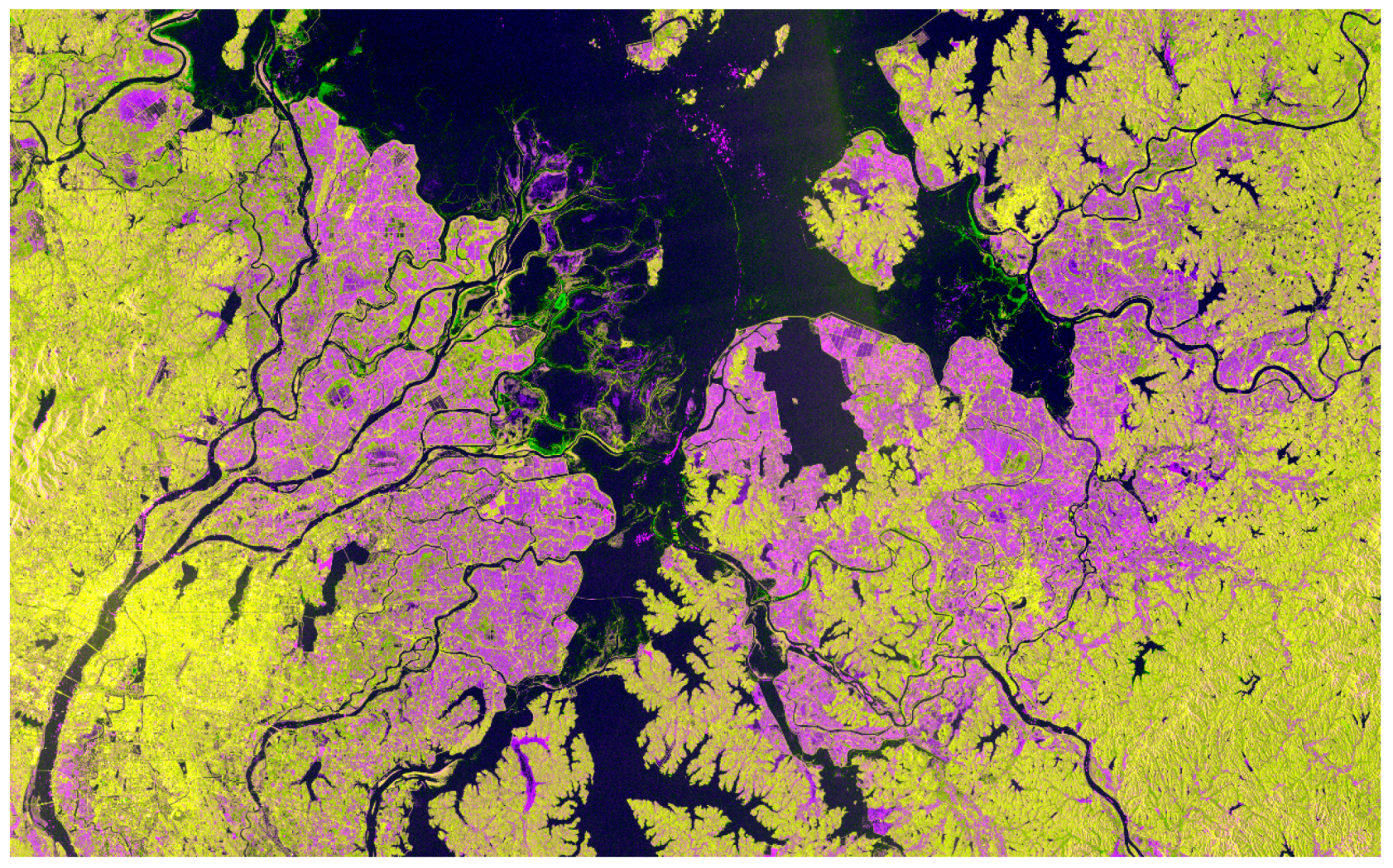
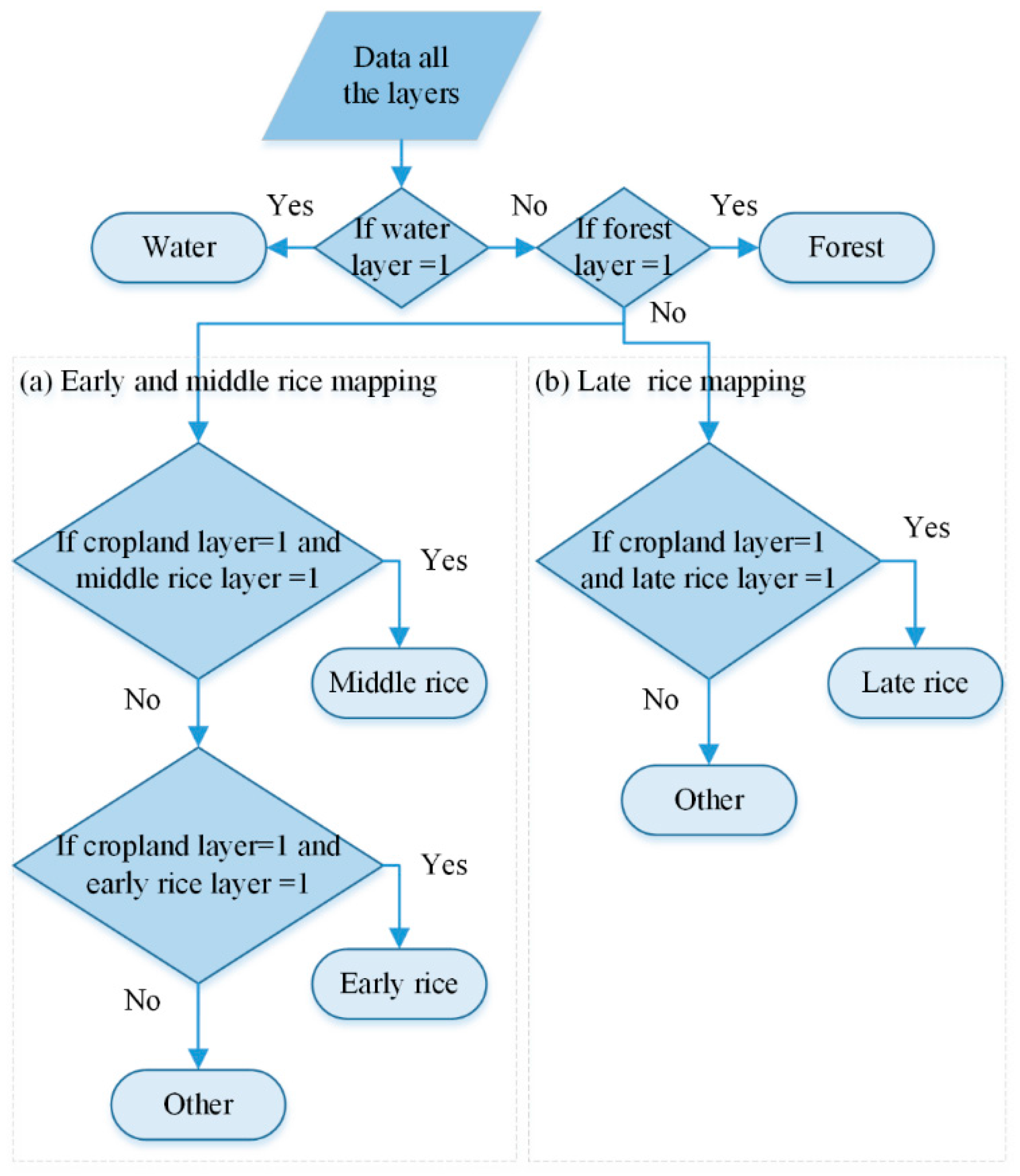
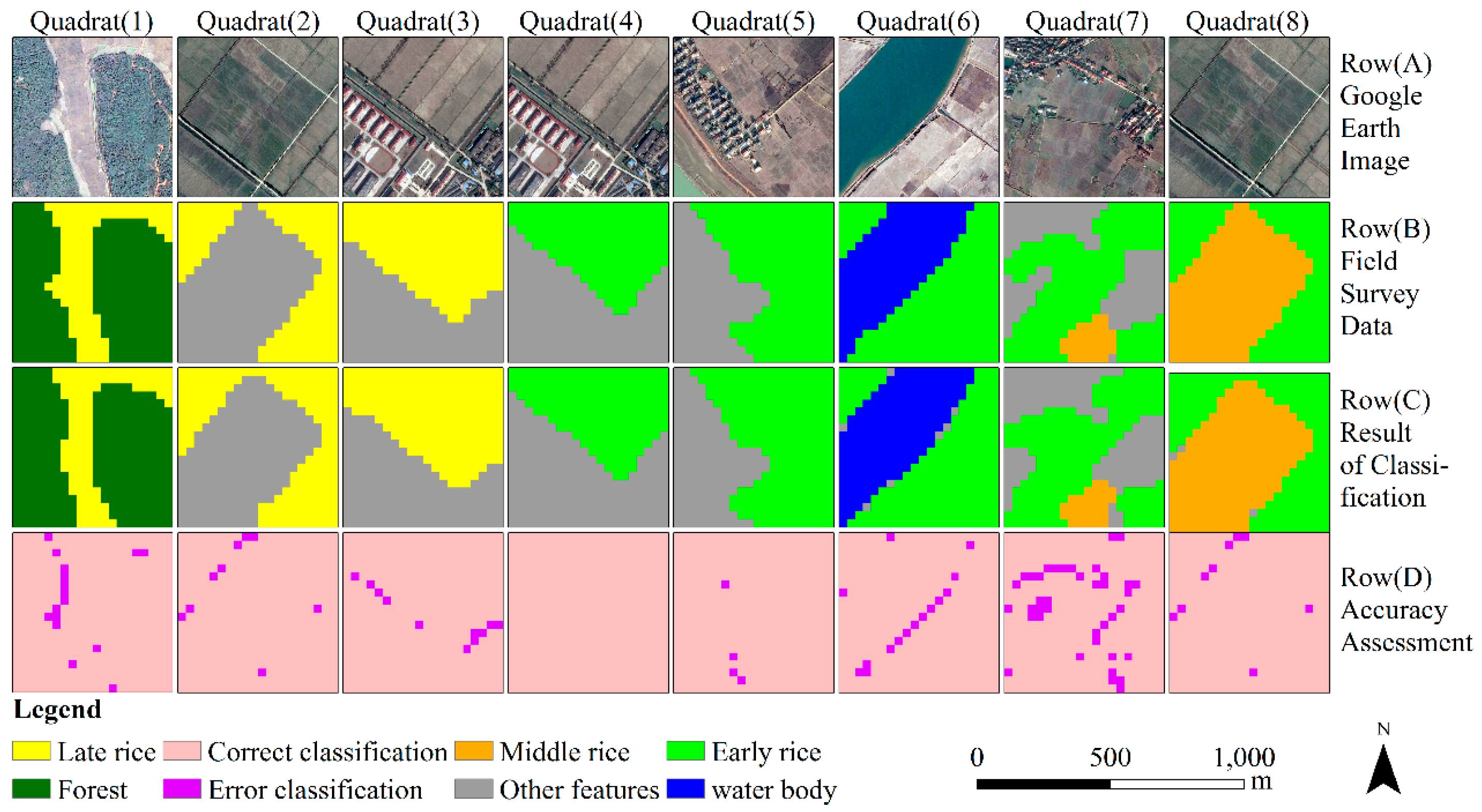
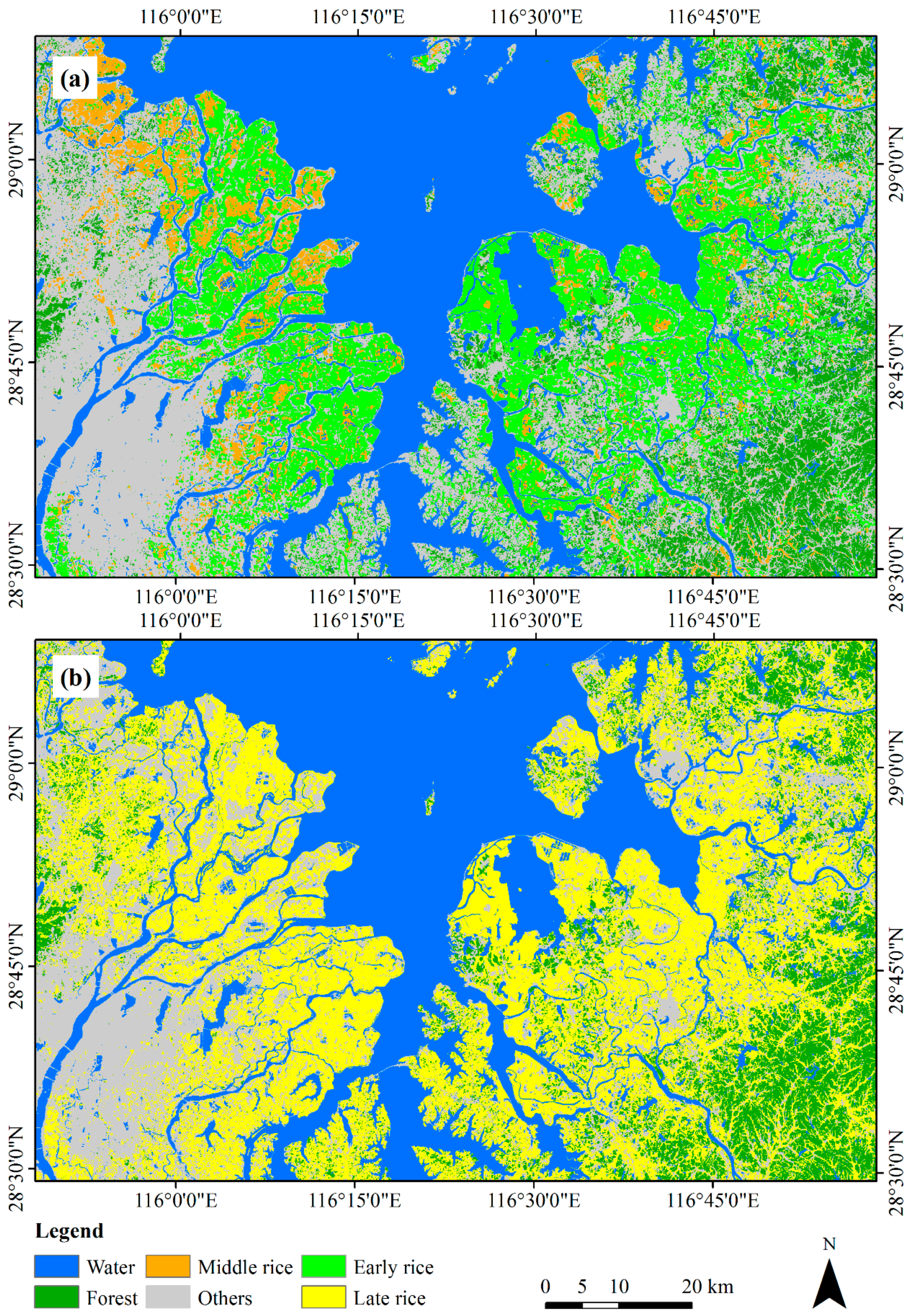
| (a) Error Matrix of Sample Counts (Unit, Pixel) | (b) Error Matrix of Estimated Area Proportion | ||||||||||||
|---|---|---|---|---|---|---|---|---|---|---|---|---|---|
| j | 1 | 2 | … | q | Total | j | 1 | 2 | … | q | Total | ||
| i | i | ||||||||||||
| 1 | n11 | n12 | … | n1q | n1• | 1 | p11 | p12 | … | p1q | p1• | ||
| 2 | n21 | n22 | … | n2q | n2• | 2 | p21 | p22 | … | p2q | p2• | ||
| ⁞ | ⁞ | ⁞ | ⁞ | ⁞ | ⁞ | ⁞ | ⁞ | ⁞ | ⁞ | ⁞ | ⁞ | ||
| q | nq1 | nq2 | … | nqq | nq• | q | pq1 | pq2 | … | pqq | pq• | ||
| Total | n•1 | n•2 | … | n•q | n | Total | p•1 | p•2 | … | p•q | 1 | ||
| Accuracy Type | Early Rice | Middle Rice | Late Rice |
|---|---|---|---|
| User’s accuracy (%) | 97.93 ± 0.11 | 98.21 ± 0.05 | 96.35 ± 0.42 |
| Producer’s accuracy (%) | 95.39 ± 0.33 | 95.92 ± 0.14 | 96.80 ± 0.44 |
| Area Type | Early Rice | Middle Rice | Late Rice |
|---|---|---|---|
| Classification area (km2) | 1588.39 | 592.15 | 3152.73 |
| Adjusted area with 95% confidence interval (km2) | 1630.84 ± 58.21 | 556.21 ± 24.70 | 3138.37 ± 77.62 |
© 2018 by the authors. Licensee MDPI, Basel, Switzerland. This article is an open access article distributed under the terms and conditions of the Creative Commons Attribution (CC BY) license (http://creativecommons.org/licenses/by/4.0/).
Share and Cite
Tian, H.; Wu, M.; Wang, L.; Niu, Z. Mapping Early, Middle and Late Rice Extent Using Sentinel-1A and Landsat-8 Data in the Poyang Lake Plain, China. Sensors 2018, 18, 185. https://doi.org/10.3390/s18010185
Tian H, Wu M, Wang L, Niu Z. Mapping Early, Middle and Late Rice Extent Using Sentinel-1A and Landsat-8 Data in the Poyang Lake Plain, China. Sensors. 2018; 18(1):185. https://doi.org/10.3390/s18010185
Chicago/Turabian StyleTian, Haifeng, Mingquan Wu, Li Wang, and Zheng Niu. 2018. "Mapping Early, Middle and Late Rice Extent Using Sentinel-1A and Landsat-8 Data in the Poyang Lake Plain, China" Sensors 18, no. 1: 185. https://doi.org/10.3390/s18010185
APA StyleTian, H., Wu, M., Wang, L., & Niu, Z. (2018). Mapping Early, Middle and Late Rice Extent Using Sentinel-1A and Landsat-8 Data in the Poyang Lake Plain, China. Sensors, 18(1), 185. https://doi.org/10.3390/s18010185







